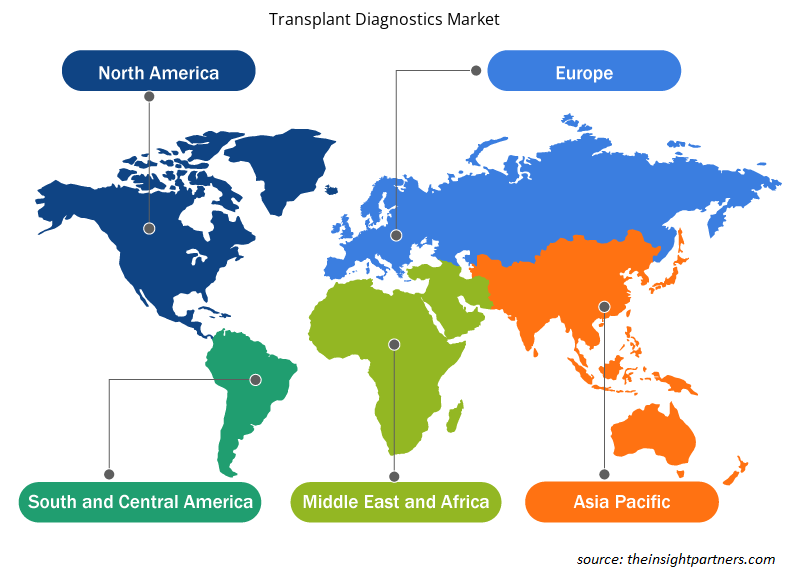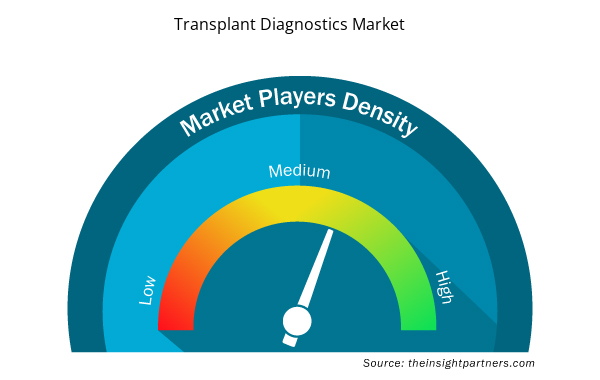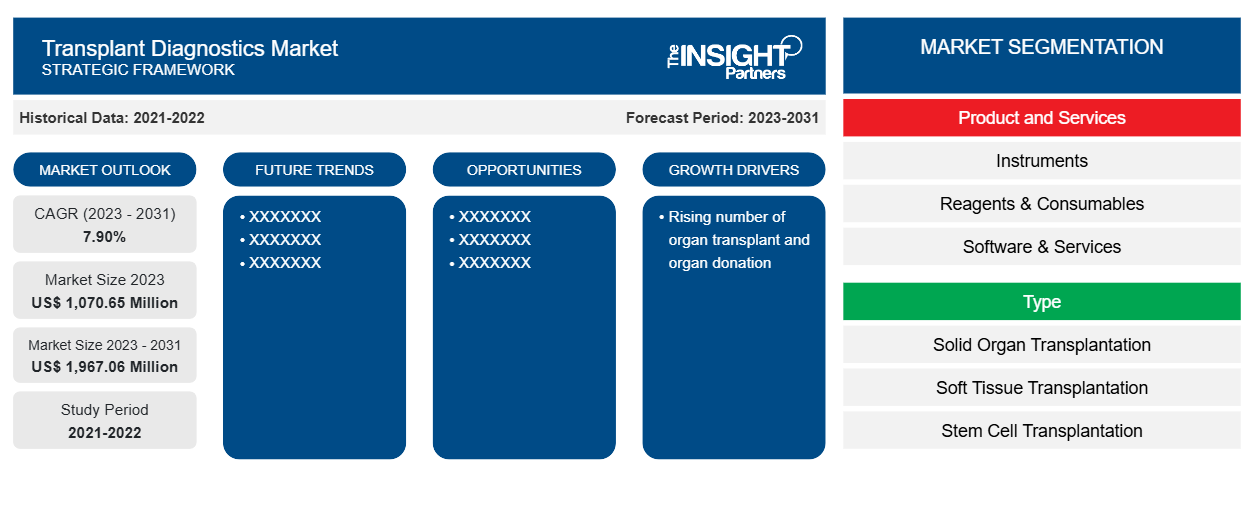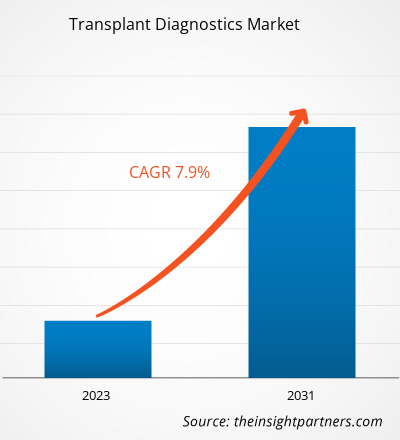Si prevede che la dimensione del mercato della diagnostica dei trapianti raggiungerà 1.967,06 milioni di $ entro il 2031 da 1.070,65 milioni di $ nel 2023. Si prevede che il mercato registrerà un CAGR del 7,90% nel 2023-2031. Si prevede che il numero crescente di procedure di trapianto di organi a livello globale, come trapianti di fegato, rene, cuore e polmone, stimolerà la domanda di diagnostica dei trapianti, aumentando a sua volta la crescita complessiva del mercato. Inoltre, la crescente prevalenza di insufficienza d'organo e malattie croniche che richiedono procedure di trapianto probabilmente rimarranno tendenze chiave del mercato della diagnostica dei trapianti.
Analisi di mercato della diagnostica dei trapianti
Il trapianto è uno dei trattamenti più preferiti per i pazienti affetti da malattie renali e sottoposti a dialisi cronica. È anche una scelta praticabile considerata nei pazienti che soffrono di malattie cardiache o epatiche. La diagnostica in tutto il mondo è migliorata in modo significativo poiché le aziende hanno sviluppato migliori tecnologie di tipizzazione HLA, monitoraggio degli anticorpi, strumenti e software. Questa tecnologia viene utilizzata per la diagnostica durante il trapianto di organi. I progressi nelle procedure di trapianto offrono un'importante opportunità di crescita del mercato.
Panoramica del mercato della diagnostica dei trapianti
Il Nord America è il mercato più grande per la crescita del mercato della diagnostica dei trapianti, con gli Stati Uniti che detengono la quota di mercato più grande, seguiti dal Canada. La crescita nel Nord America è caratterizzata dal crescente numero di trapianti di organi e dalla crescente prevalenza di insufficienza d'organo in questa regione. Secondo i dati pubblicati su United Network for Organ Sharing.org, si stima che nel 2023 negli Stati Uniti siano state eseguite circa 46.630 procedure di trapianto. Allo stesso modo, secondo donatelife.net nel 2022, gli Stati Uniti hanno raggiunto un traguardo storico, realizzando circa 1 milione di trapianti di organi rispetto a qualsiasi altro paese al mondo. Nel 2023, oltre 23.000 donatori hanno portato nuova vita ai riceventi e alle loro famiglie. Inoltre, circa 100.000 persone sono in lista d'attesa per trapianti di organi salvavita. Pertanto, è probabile che il crescente numero di trapianti di organi nel paese stimoli la crescita del mercato nei prossimi anni.
Personalizza questo report in base alle tue esigenze
Riceverai la personalizzazione gratuita di qualsiasi report, comprese parti di questo report, o analisi a livello nazionale, pacchetto dati Excel, oltre a usufruire di grandi offerte e sconti per start-up e università
- Scopri le principali tendenze di mercato in questo rapporto.Questo campione GRATUITO includerà analisi di dati che spaziano dalle tendenze di mercato alle stime e alle previsioni.
Driver e opportunità del mercato della diagnostica dei trapianti
L'aumento dell'incidenza di malattie croniche che richiedono procedure di trapianto di organi favorisce il mercato
La crescente necessità di trapianti di organi è integrata dalla crescente prevalenza di malattie croniche come diabete e malattie renali, che sta ulteriormente spingendo il mercato per la diagnostica dei trapianti. Ad esempio, secondo i dati pubblicati dall'Università della California di San Francisco, circa 750.000 pazienti negli Stati Uniti e circa 2 milioni di pazienti a livello globale sono affetti da insufficienza renale ogni anno. Quindi, con queste insufficienze di organi, anche la necessità di reni da donatori negli Stati Uniti sta aumentando dell'8% all'anno. Paesi come Giappone, Taiwan, Messico, Stati Uniti e Belgio detengono la più alta prevalenza di insufficienza renale.
Integrazione di intelligenza artificiale e apprendimento automatico: un’opportunità nel mercato della diagnostica dei trapianti
Una combinazione di algoritmi di intelligenza artificiale (IA) e apprendimento automatico ha mostrato risultati promettenti nel mercato della diagnostica dei trapianti e può migliorare i risultati dei pazienti, accelerare l'analisi dei dati e aumentare l'accuratezza diagnostica, il che può portare all'espansione del mercato. La domanda di trapianti è aumentata a causa di vari fattori chiave, come l'invecchiamento della popolazione, la crescente prevalenza di malattie croniche e i progressi nei dispositivi medici che consentono a una gamma più ampia di pazienti di essere idonei al trapianto.
Analisi della segmentazione del rapporto di mercato sulla diagnostica dei trapianti
I segmenti chiave che hanno contribuito alla derivazione dell'analisi di mercato della diagnostica dei trapianti sono prodotti e servizi, tipologia, tecnologia e utenti finali.
- In base a Prodotti e Servizi, il mercato della Diagnostica dei Trapianti è segmentato in Strumenti, Reagenti e Materiali di Consumo e Software e Servizi. Strumenti, Reagenti e Materiali di Consumo e Software e Servizi. I reagenti e i materiali di consumo hanno detenuto la quota maggiore del mercato nel 2023. Software e Servizi hanno registrato il CAGR più elevato nel periodo di previsione 2023-2031.CAGR over the forecast period 2023-2031.
- Per tipo, il mercato è segmentato in trapianto di organi solidi , trapianto di tessuti molli e trapianto di cellule staminali. Il segmento del trapianto di organi solidi ha detenuto la quota maggiore del mercato nel 2023.
- In base alla tecnologia, il mercato è segmentato in saggi molecolari e saggi non molecolari. Si prevede che il segmento dei saggi molecolari registrerà il CAGR più elevato nel periodo di previsione.
- Per utente finale, il mercato è segmentato in ospedali e centri trapianti, laboratori di ricerca e istituti accademici e laboratori di riferimento indipendenti. Il segmento ospedali e centri trapianti ha detenuto la quota maggiore del mercato nel 2023.
Analisi della quota di mercato della diagnostica dei trapianti per area geografica
L'ambito geografico del rapporto sul mercato della diagnostica dei trapianti è suddiviso principalmente in cinque regioni: Nord America, Asia Pacifico, Europa, Medio Oriente e Africa, Sud e Centro America.
Il Nord America ha dominato il mercato della diagnostica dei trapianti. La crescita del mercato può essere attribuita a una crescente prevalenza di insufficienza d'organo e un numero crescente di donazioni di organi insieme a procedure di trapianto di organi sta alimentando la crescita del mercato regionale. Ad esempio, secondo i dati pubblicati dall'Association of Organ Procurement Organizations (AOPO), un'organizzazione senza scopo di lucro negli Stati Uniti, afferma che a gennaio 2021, più di 12.500 persone hanno donato uno o più organi nel 2020 e il numero di organi donati da donatori deceduti è aumentato a oltre 36.500, ovvero quasi il 2% in più rispetto all'anno precedente. Inoltre, gli organi dei defunti hanno salvato più di 33.000 vite negli ultimi sette anni.
Pertanto, l'aumento delle donazioni di organi crea la necessità di maggiori test diagnostici per i trapianti, stimolando così la crescita del mercato.
Approfondimenti regionali sul mercato della diagnostica dei trapianti
Le tendenze regionali e i fattori che influenzano il Transplant Diagnostics Market durante il periodo di previsione sono stati ampiamente spiegati dagli analisti di Insight Partners. Questa sezione discute anche i segmenti e la geografia del Transplant Diagnostics Market in Nord America, Europa, Asia Pacifico, Medio Oriente e Africa e Sud e Centro America.

- Ottieni i dati specifici regionali per il mercato della diagnostica dei trapianti
Ambito del rapporto di mercato sulla diagnostica dei trapianti
| Attributo del report | Dettagli |
|---|---|
| Dimensioni del mercato nel 2023 | 1.070,65 milioni di dollari USA |
| Dimensioni del mercato entro il 2031 | 1.967,06 milioni di dollari USA |
| CAGR globale (2023-2031) | 7,90% |
| Dati storici | 2021-2022 |
| Periodo di previsione | 2023-2031 |
| Segmenti coperti | Per prodotto e servizi
|
| Regioni e Paesi coperti | America del Nord
|
| Leader di mercato e profili aziendali chiave |
|
Densità degli attori del mercato: comprendere il suo impatto sulle dinamiche aziendali
Il mercato della diagnostica dei trapianti sta crescendo rapidamente, spinto dalla crescente domanda degli utenti finali dovuta a fattori quali l'evoluzione delle preferenze dei consumatori, i progressi tecnologici e una maggiore consapevolezza dei benefici del prodotto. Con l'aumento della domanda, le aziende stanno ampliando le loro offerte, innovando per soddisfare le esigenze dei consumatori e capitalizzando sulle tendenze emergenti, il che alimenta ulteriormente la crescita del mercato.
La densità degli operatori di mercato si riferisce alla distribuzione di aziende o società che operano in un particolare mercato o settore. Indica quanti concorrenti (operatori di mercato) sono presenti in un dato spazio di mercato in relazione alle sue dimensioni o al valore di mercato totale.
Le principali aziende che operano nel mercato della diagnostica dei trapianti sono:
- Laboratori Bio-Rad,
- Ologico,
- Illumina, Inc.,
- Termo Fisher Scientifico,
- QIAGEN NV
- Omixon, Inc.
Disclaimer : le aziende elencate sopra non sono classificate secondo un ordine particolare.

- Ottieni una panoramica dei principali attori del mercato della diagnostica dei trapianti
Notizie e sviluppi recenti sul mercato della diagnostica dei trapianti
Il mercato della diagnostica dei trapianti viene valutato raccogliendo dati qualitativi e quantitativi post-ricerca primaria e secondaria, che includono importanti pubblicazioni aziendali, dati di associazioni e database. Di seguito è riportato un elenco degli sviluppi nel mercato della diagnostica dei trapianti:
- Thermo Fisher Scientific ha aggiunto due nuovi prodotti al suo portafoglio di diagnostica per trapianti durante la conferenza annuale dell'American Society for Histocompatibility and Immunogenetics (ASHI). (Fonte: Thermo Fisher Scientific, comunicato stampa/sito Web aziendale/newsletter, ottobre 2023)
- Immucor, Inc., un'azienda focalizzata sulla diagnostica delle trasfusioni e dei trapianti, ha annunciato due aggiunte al suo portafoglio di diagnostica dei trapianti, dimostrando il suo impegno continuo verso nuovi progressi nel campo dell'istocompatibilità. (Fonte: Immucor, comunicato stampa/sito Web aziendale/newsletter, marzo 2022)
- Biocartis e Ophiomics hanno avviato una collaborazione per concentrarsi sulla commercializzazione di HepatoPredict, un test di espressione genica prognostica per identificare quali pazienti trarranno beneficio dal trapianto di fegato (Fonte: Biocartis, comunicato stampa/sito Web aziendale/newsletter, marzo 2022)
Copertura e risultati del rapporto di mercato sulla diagnostica dei trapianti
Il rapporto "Dimensioni e previsioni del mercato della diagnostica dei trapianti (2021-2031)" fornisce un'analisi dettagliata del mercato che copre le seguenti aree:
- Dimensioni e previsioni del mercato a livello globale, regionale e nazionale per tutti i segmenti di mercato chiave coperti dall'ambito
- Dinamiche di mercato come fattori trainanti, vincoli e opportunità chiave
- Principali tendenze future
- Analisi dettagliata delle cinque forze PEST/Porter e SWOT
- Analisi di mercato globale e regionale che copre le principali tendenze di mercato, i principali attori, le normative e gli sviluppi recenti del mercato
- Analisi del panorama industriale e della concorrenza che copre la concentrazione del mercato, l'analisi della mappa di calore, i principali attori e gli sviluppi recenti
- Profili aziendali dettagliati
- Analisi storica (2 anni), anno base, previsione (7 anni) con CAGR
- Analisi PEST e SWOT
- Valore/volume delle dimensioni del mercato - Globale, regionale, nazionale
- Industria e panorama competitivo
- Set di dati Excel



Report Coverage
Revenue forecast, Company Analysis, Industry landscape, Growth factors, and Trends

Segment Covered
This text is related
to segments covered.

Regional Scope
North America, Europe, Asia Pacific, Middle East & Africa, South & Central America

Country Scope
This text is related
to country scope.
Trends and growth analysis reports related to Life Sciences : READ MORE..
The Insight Partners performs research in 4 major stages: Data Collection & Secondary Research, Primary Research, Data Analysis and Data Triangulation & Final Review.
- Data Collection and Secondary Research:
As a market research and consulting firm operating from a decade, we have published and advised several client across the globe. First step for any study will start with an assessment of currently available data and insights from existing reports. Further, historical and current market information is collected from Investor Presentations, Annual Reports, SEC Filings, etc., and other information related to company’s performance and market positioning are gathered from Paid Databases (Factiva, Hoovers, and Reuters) and various other publications available in public domain.
Several associations trade associates, technical forums, institutes, societies and organization are accessed to gain technical as well as market related insights through their publications such as research papers, blogs and press releases related to the studies are referred to get cues about the market. Further, white papers, journals, magazines, and other news articles published in last 3 years are scrutinized and analyzed to understand the current market trends.
- Primary Research:
The primarily interview analysis comprise of data obtained from industry participants interview and answers to survey questions gathered by in-house primary team.
For primary research, interviews are conducted with industry experts/CEOs/Marketing Managers/VPs/Subject Matter Experts from both demand and supply side to get a 360-degree view of the market. The primary team conducts several interviews based on the complexity of the markets to understand the various market trends and dynamics which makes research more credible and precise.
A typical research interview fulfils the following functions:
- Provides first-hand information on the market size, market trends, growth trends, competitive landscape, and outlook
- Validates and strengthens in-house secondary research findings
- Develops the analysis team’s expertise and market understanding
Primary research involves email interactions and telephone interviews for each market, category, segment, and sub-segment across geographies. The participants who typically take part in such a process include, but are not limited to:
- Industry participants: VPs, business development managers, market intelligence managers and national sales managers
- Outside experts: Valuation experts, research analysts and key opinion leaders specializing in the electronics and semiconductor industry.
Below is the breakup of our primary respondents by company, designation, and region:

Once we receive the confirmation from primary research sources or primary respondents, we finalize the base year market estimation and forecast the data as per the macroeconomic and microeconomic factors assessed during data collection.
- Data Analysis:
Once data is validated through both secondary as well as primary respondents, we finalize the market estimations by hypothesis formulation and factor analysis at regional and country level.
- Macro-Economic Factor Analysis:
We analyse macroeconomic indicators such the gross domestic product (GDP), increase in the demand for goods and services across industries, technological advancement, regional economic growth, governmental policies, the influence of COVID-19, PEST analysis, and other aspects. This analysis aids in setting benchmarks for various nations/regions and approximating market splits. Additionally, the general trend of the aforementioned components aid in determining the market's development possibilities.
- Country Level Data:
Various factors that are especially aligned to the country are taken into account to determine the market size for a certain area and country, including the presence of vendors, such as headquarters and offices, the country's GDP, demand patterns, and industry growth. To comprehend the market dynamics for the nation, a number of growth variables, inhibitors, application areas, and current market trends are researched. The aforementioned elements aid in determining the country's overall market's growth potential.
- Company Profile:
The “Table of Contents” is formulated by listing and analyzing more than 25 - 30 companies operating in the market ecosystem across geographies. However, we profile only 10 companies as a standard practice in our syndicate reports. These 10 companies comprise leading, emerging, and regional players. Nonetheless, our analysis is not restricted to the 10 listed companies, we also analyze other companies present in the market to develop a holistic view and understand the prevailing trends. The “Company Profiles” section in the report covers key facts, business description, products & services, financial information, SWOT analysis, and key developments. The financial information presented is extracted from the annual reports and official documents of the publicly listed companies. Upon collecting the information for the sections of respective companies, we verify them via various primary sources and then compile the data in respective company profiles. The company level information helps us in deriving the base number as well as in forecasting the market size.
- Developing Base Number:
Aggregation of sales statistics (2020-2022) and macro-economic factor, and other secondary and primary research insights are utilized to arrive at base number and related market shares for 2022. The data gaps are identified in this step and relevant market data is analyzed, collected from paid primary interviews or databases. On finalizing the base year market size, forecasts are developed on the basis of macro-economic, industry and market growth factors and company level analysis.
- Data Triangulation and Final Review:
The market findings and base year market size calculations are validated from supply as well as demand side. Demand side validations are based on macro-economic factor analysis and benchmarks for respective regions and countries. In case of supply side validations, revenues of major companies are estimated (in case not available) based on industry benchmark, approximate number of employees, product portfolio, and primary interviews revenues are gathered. Further revenue from target product/service segment is assessed to avoid overshooting of market statistics. In case of heavy deviations between supply and demand side values, all thes steps are repeated to achieve synchronization.
We follow an iterative model, wherein we share our research findings with Subject Matter Experts (SME’s) and Key Opinion Leaders (KOLs) until consensus view of the market is not formulated – this model negates any drastic deviation in the opinions of experts. Only validated and universally acceptable research findings are quoted in our reports.
We have important check points that we use to validate our research findings – which we call – data triangulation, where we validate the information, we generate from secondary sources with primary interviews and then we re-validate with our internal data bases and Subject matter experts. This comprehensive model enables us to deliver high quality, reliable data in shortest possible time.


 Ottieni un campione gratuito per questo repot
Ottieni un campione gratuito per questo repot